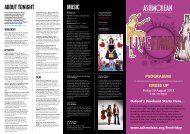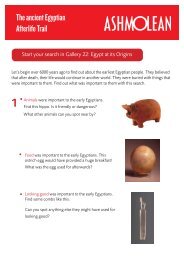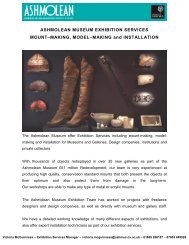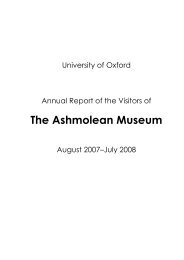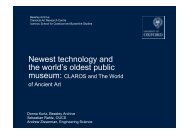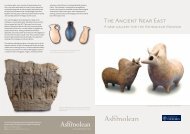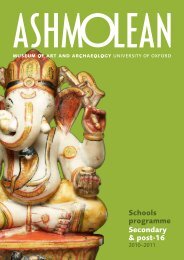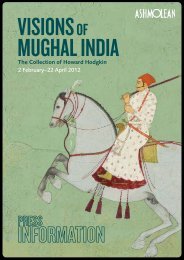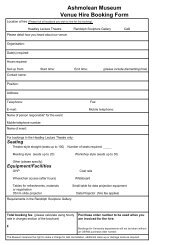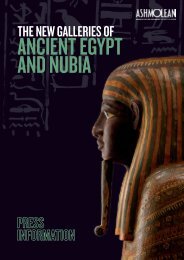Anatolia: Bronze and Iron Ages - The Ashmolean Museum
Anatolia: Bronze and Iron Ages - The Ashmolean Museum
Anatolia: Bronze and Iron Ages - The Ashmolean Museum
Create successful ePaper yourself
Turn your PDF publications into a flip-book with our unique Google optimized e-Paper software.
ANCIENT NEAR EASTERN TERRACOTTAS<br />
mouth is an incised slit with vertical incisions below on the chin (“beard”); the ears <strong>and</strong> what was originally<br />
a major protrusion (“polos”) on the head are broken off; the upper body is flattened, with triangular shape<br />
accentuated by projecting shoulders; attenuated arms extended down either side of the body with the h<strong>and</strong>s<br />
grasping the knees; incised lines on the upper arms <strong>and</strong> shoulders; incised crossing straps <strong>and</strong> what may be<br />
a necklace; pointed breasts with incised nipples; genitals represented by an incised rectangular with incised<br />
dots inside it; short lower body with stump legs.<br />
AN1910.697: H: 9.7cm. obtained at Izmir (“Smyrna”) by D.G. Hogarth as from the area of Thyateira<br />
(Akhisar: map in Korfmann 1979).<br />
Ormerod 1912–13, 54–5, fig. 3; Korfmann 1979, 190, 197, pl. 29; Obladen-Kauder 1996, 276, n.737).<br />
Three miniature vessels (AN1910.694–6) were acquired with this figurine; but there is no evidence of a<br />
direct association.<br />
Korfmann (1979) was the first to place this figurine in its chronological <strong>and</strong> cultural context by<br />
comparison with terracottas from Demircihüyük, to the north west of Akhisar, whence it was reported<br />
to have come. Akhisar is some thirty-five kilometres south of Yortan (east of Pergamon), where in 1901<br />
French archaeologists excavated an extra-mural cemetery yielding finely made pottery of Troy I–II type,<br />
comparable in some cases to the miniature vessels reported with this figurine. <strong>The</strong> parallel figurines at<br />
Demircihüyük, were attributed to levels L <strong>and</strong> K (Korfmann 1979, 187, 191; see now Obladen-Kauder<br />
1996). Surviving undamaged heads of comparable figurines from other west <strong>Anatolia</strong>n sites of the Early<br />
<strong>Bronze</strong> Age allow for reconstruction of a cylindrical projection at the back of the head, behind the diskshaped<br />
face (cf. Korfmann 1979, fig. 1: 1, 3; fig. 3,5,6). A very similar, more complete figure of the same<br />
seated type as no. 383 is illustrated as from Çikick, some two hundred <strong>and</strong> fifty kilometres east of Akhisar,<br />
by Korfmann (1979, fig. 6). It is difficult to establish whether the projection is a headdress or whether it<br />
is the hair dressed into a high knot, or a combination of the two (cf. Obladen-Kauder 1996, 267). <strong>The</strong>re<br />
is no certainty as to whether such figurines represented a goddess or a female member of the local<br />
community (cf. Obladen-Kauder 1996, 257–9). Korfmann (1979) identified her as a goddess.<br />
(ii) <strong>Iron</strong> Age<br />
384. Upper part of a warrior, broken off at the waist; baked; crudely modelled by h<strong>and</strong>;<br />
burnished, chocolate brown fabric wears a partly broken conical helmet or leather cap;<br />
pierced eyes; pointed nose; roughly indicated mouth, chin <strong>and</strong> beard; spear held in right<br />
h<strong>and</strong>, round shield with boss in left.<br />
AN1911.311 (“bought in the bazaar at Isbarta”, southwest Turkey) H: 6.9cm W: 3.3 cm.<br />
Ormerod 1912–13, 53–4, fig. 2a.<br />
This figurine is so crudely made that little may be said about it beyond an attribution to the<br />
mature <strong>Iron</strong> Age, when the warrior’s equipment is most readily paralleled; but whether it is<br />
of the Achaemenid Period, or somewhat earlier, is uncertain. <strong>The</strong>re are no obvious grounds for doubting<br />
its antiquity.<br />
385. Horse-rider: male; head detached from body when acquired; baked; h<strong>and</strong>modelled; coarse<br />
orange fabric with polished slip originally; head, nearly globular, has large ears, prominent eyes<br />
beneath arched brows, passing directly into a prominent straight-edged nose; mouth slightly<br />
indicated; chin damaged; wears a prominent “Phrygian” cap, depressed at the sides, with a<br />
high ridge front to back; the left arm <strong>and</strong> the right below the elbow are missing; the width <strong>and</strong><br />
distortion of the groin indicate that it was made to be mounted as a rider; the trunk of the<br />
body is a flattened cylinder; very worn surface, but simple geometric designs in black are still<br />
evident in traces on the top <strong>and</strong> sides of the back, indicating a garment; black is also still<br />
evident on the eyes <strong>and</strong> cap rim; at the base of the back is a broad triangular patch of brown<br />
colour. Myres (AN1903.399) thought this might indicate a “saddle”, of which there may also<br />
be painted traces at the front. It could, however, simple indicate the groin area of the costume.<br />
AN1909.943 (“from the Hammam or hot springs 1½ miles east of Keuhne, near the site of<br />
MITHRADATEION on the border between Galatia, Cappadocia, <strong>and</strong> Pontus... secured by Mr Anderson”<br />
(Myres 1903, 378–9); given by J.W. Crowfoot. H: 20.5cm. W: 6.3cm (base).<br />
-240




